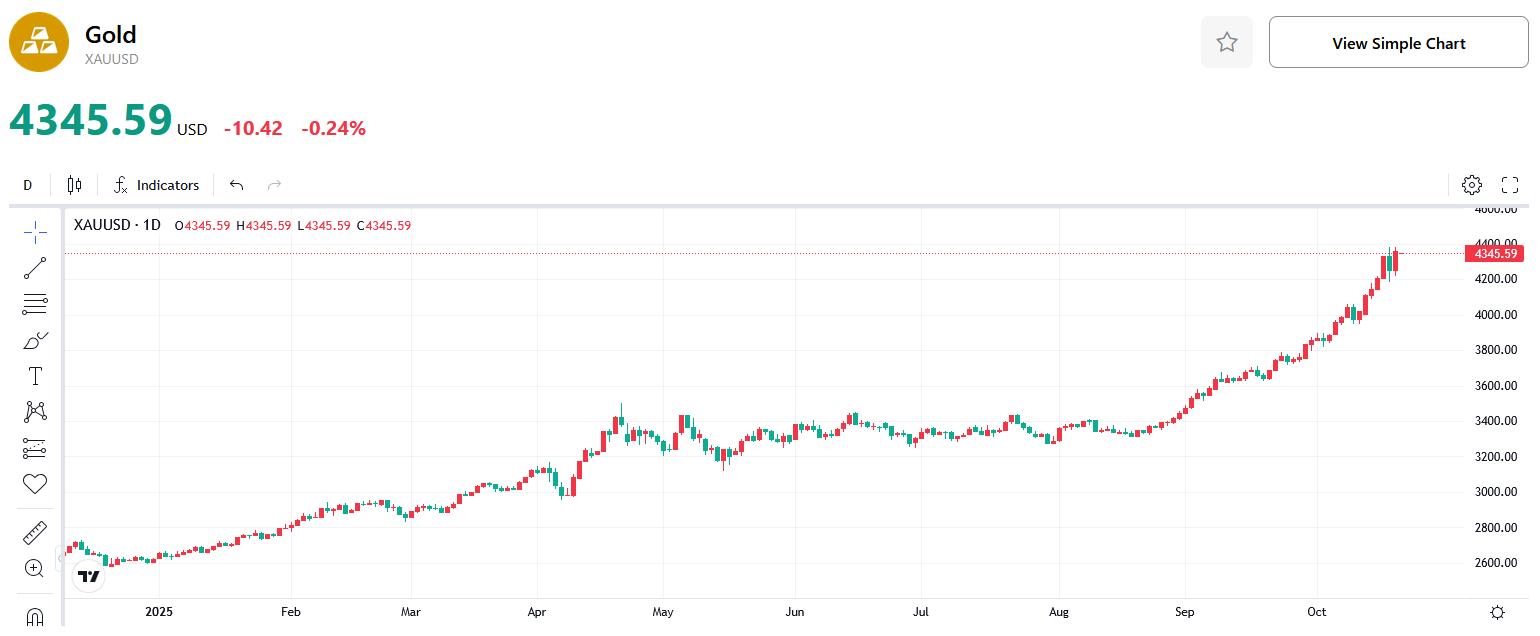"No Kings" Protests: If It Persists, Sell U.S. Stocks and Buy Gold

1. Introduction
TradingKey - On the morning of Saturday, 18 October, large-scale demonstrations broke out in multiple U.S. cities, where people protested against Trump's policies. Rallies were held in cities including New York, Washington, D.C., Chicago, Miami, and Los Angeles. Demonstrators packed streets and subway entrances, with slogans on their signs such as "Democracy is not a monarchy" and "The Constitution is not optional."
From an economic perspective, the demonstrations are having a negative impact. In the financial market, U.S. stocks and gold will show divergent trends: specifically, the demonstrations are bearish for U.S. stocks and bullish for gold. Therefore, if investors anticipate that the "No Kings" protests will continue to escalate, they should take action to sell U.S. stocks and buy gold.
Figure 1: Gold Prices ($/oz)

Source: TradingKey
2. Impact on U.S. Stocks and the U.S. Dollar
If the "No Kings" protests persist, they will exert adverse effects on U.S. stocks. Should the movement continue and escalate into prolonged social unrest, it will deliver a significant negative shock to the U.S. stock market. History, such as the 2020 Black Lives Matter protests, shows that similar events amplify market uncertainty, undermining investor confidence and triggering asset sell-offs. Below is an analysis of its impact from key dimensions.
First, political uncertainty will drive up market volatility. Sustained demonstrations may exacerbate congressional gridlock or trigger radical policy responses, disrupting corporate supply chains. U.S. stocks are sensitive to risk events, so the VIX Fear Index is likely to surge, dragging down the S&P 500 Index and the Nasdaq Composite Index in the short term. If the situation evolves into strikes or conflicts—similar to the 2011 "Occupy Wall Street" movement—it will amplify systemic risks.
Second, economic disruptions will erode corporate profits. If demonstrations block transportation hubs or trigger street clashes, they will disrupt logistics, retail, and manufacturing sectors. Financial centres like New York and Chicago will be hit the hardest. Giants such as Amazon and Walmart may face delivery delays and store closures, leading to a decline in quarterly revenue. Consumer confidence indices often plummet during periods of unrest. During the 2020 pandemic, combined with protests, this index dropped significantly. Reduced consumer spending will drag down GDP growth, which in turn will squeeze corporate profit margins and trigger a downward revision of stock market valuations.
Third, investor sentiment will turn negative, exacerbating capital outflows. International investors hold large positions in U.S. stocks. Persistent protests are seen as a sign of institutional instability, potentially triggering the withdrawal of tens of billions of U.S. dollars in foreign capital. A weaker U.S. dollar will push up import costs and inflation expectations. The Federal Reserve’s slower pace of interest rate cuts will increase corporate borrowing costs, hitting technology growth stocks. The Nasdaq Index is most vulnerable during crises. As global capital flows into safe-haven assets, the market value of U.S. stocks may suffer massive evaporation.
In terms of currency, if the "No Kings" protests persist, they will fundamentally exert multiple bearish impacts on the U.S. dollar. The U.S. dollar’s status as a reserve currency and its safe-haven attribute rely on global trust in America’s political stability and institutional resilience. However, this large-scale protest against "authoritarian tendencies" is directly undermining this trust foundation. Prolonged unrest may reduce the government’s ability to advance economic policies such as fiscal and trade measures, which will damage market confidence in U.S. dollar assets. Meanwhile, social division will weaken business and consumer confidence, dragging down economic fundamentals—these fundamentals are the core support for the U.S. dollar’s strength. International investors will demand higher returns due to increased risks, potentially triggering capital outflows and suppressing the U.S. dollar exchange rate. Combined with economic losses caused by government shutdowns and credit rating risks, the U.S. Dollar Index may continue to fluctuate at a low level or even weaken further.
In conclusion, the ongoing "No Kings" protests erode U.S. stocks and the U.S. dollar through uncertainty, economic disruption, and confidence collapse. Investors should diversify risks into safe-haven assets, such as gold.
3. Impact on Gold
The ongoing escalation of the "No Kings" demonstrations is activating gold's safe-haven value through three key dimensions: political trust, economic expectations, and monetary attributes. This provides strong and sustained upward momentum for gold prices. As a non-credit hard currency, gold’s asset preservation function will be continuously amplified amid social unrest and policy disorder.
Escalating political uncertainty is the core driver fuelling gold demand. This wave of protests, sweeping 50 U.S. states and covering over 2,700 locations, essentially reflects deep-seated concerns about political polarisation in American society, shaking the global trust in the stability of U.S. institutions. Historical experience shows that when social unrest intersects with policy divisions, investors proactively shift to safe-haven assets like gold. If the demonstrations trigger a power confrontation between the federal government and local authorities, this fragmented situation will intensify uncertainty around policy implementation—driving capital to flow from risky assets such as stocks into gold. The recent continuous increase in gold ETF holdings has confirmed this trend.
The price linkage effect caused by the weakening U.S. dollar has further strengthened the positive outlook for gold. The negative correlation between the U.S. dollar and gold is particularly prominent during periods of political unrest: prolonged demonstrations may lead to an extended government shutdown, which in turn weighs on the performance of economic data. A gloomy economic outlook will then fuel expectations of interest rate cuts by the Federal Reserve, and a low-interest-rate environment reduces the holding cost of gold while enhancing its appeal as an asset.
Continuous protests will have a direct impact on the real economy, which indicates that consumer and investment confidence will be further undermined. If demonstrations result in a paralysis of fiscal policy implementation, the U.S. economic recovery process may be disrupted. This "political-economic" negative feedback loop will highlight gold's dual attributes of hedging against inflation and mitigating risks.
4. Conclusion
In summary, the "No Kings" protests hurt the economy, and the extent of this impact depends on whether the protests will continue in the long term. If investors believe that the "No Kings" protests will escalate, the revenue and profits of U.S.-listed companies will be hit. As a safe-haven asset, the price of gold is expected to keep reaching new highs. Therefore, if investors believe the protests will persist, they should sell U.S. stocks and buy gold.

* The content presented above, whether from a third party or not, is considered as general advice only. This article should not be construed as containing investment advice, investment recommendations, an offer of or solicitation for any transactions in financial instruments.



